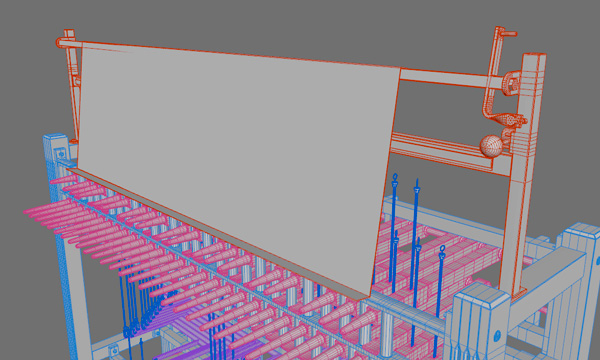
It’s time to leave the bells behind and to concentrate on the parts of the carillon inside the dome. A wooden cabin suspended directly beneath the bell chamber houses the console. The musicians who perform there remain out of sight. They, in turn, can’t see the bells or even hear them without the aid of speakers wired to microphones in the bell chamber.
The console is one of those mechanical devices – like the Wright brothers’ Flyer or a 12-speed bicycle – whose design is determined purely by function. An open frame supports a system of manual and pedal keys, levers and rods. When the keys are tapped with a foot or loosely clenched fist, wires connected to the bells above are gently tugged to make the bells ring.
Also known as the clavier, the console superficially resembles an organ or piano keyboard. Like most carillon consoles, it was custom built for the instrument.

Unfortunately, there don’t seem to be any scale drawings or blueprints of the console. Building the 2012 model involved some close scrutiny of various photos and some educated guesswork. This time, we have access to more photos and, better yet, a set of measurements taken directly from the instrument. We can use these to create our own set of scale drawings.

The drawings will be placed in Maya to guide construction of the model. We’ll begin with the frame, built of wooden uprights with horizontal aluminum structures that support the keys.

This is where the measurements are critical. It’s important to model the frame precisely – to the inch – because these dimensions will determine the size of virtually every other part of the instrument.

The sharp and natural manual keys, also called batons, follow the same basic design, though the natural keys are a few inches longer.

The sharp and natural pedal keys, on the other hand (or should we say foot), are very different.

There are 48 manual keys and 26 pedal keys – 74 in all to play 50 notes ranging from G3 to C8. Twenty-four of the pedal keys double up on notes played by the manual keys. The two left-most pedals play the lowest bells in the instrument, the bourdon (A3#) and sub-bourdon (G3).

The doubling pedal keys are connected to their manual counterparts by a system of rollerbars and linkage rods. Tapping a pedal pulls a lever connected to the rollerbar, which in turn pulls the rod connected to the manual key.

All of the manual keys are tied to the transmission wires with linkage rods and turnbuckles. Here’s a closeup of the top of the keys, minus the transmission wires. (A rendering of this view appears at the top of this post.)

More details are added as needed, with the music rack being the final large assembly to be added.

The bench is modeled separately and added to the scene. The console is complete and ready for shading.